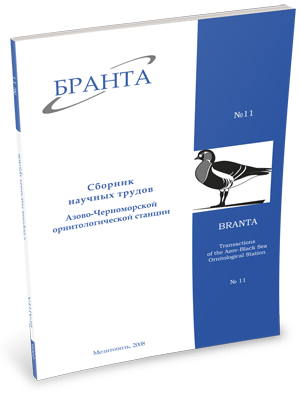
Transactions
of the Azov-Black Sea Ornithological Station



Long-term monitoring of the Cormorant (Phalacrocorax carbo) settlements in sea bays of the northern Black Sea region
A.G. Rudenko, T.B. Ardamatskaya, O.A. Yaremchenko
This paper presents materials of a long-term monitoring of colonies of the Cormorant (Phalacrocorax carbo), nesting on islands of three bays of the Black Sea (Tendrovsky, Yagorlytsky and Dzharylgachsky Bays). Researches have been carried out from the end of 1980s to the present time.
Distribution of nesting sites, number dynamics, types of settlements and reproductive parameters
During 1989-2007 continuous increase in numbers of nesting birds was observed. In Tendrovsky Bay number of the Cormorants had grown and in some years it was 4.6-9.8 times higher than in 1990s, in Yagorlytsky Bay - 2.8-4.1 times higher. In Dzharylgachsky Bay their numbers sharply increase in 2000s - 3.4 times higher than in 1995 (Table 1). As a whole, number of the Cormorant in its nesting settlements in three sea bays of the Black Sea region at the present time is almost three times higher than in 1995 and totals about 10000 nesting pairs. The proportion of number of breeding pairs in different bays fluctuates in different years during the period of survey: from 13.6 up to 75.3 %% in Tendrovsky Bay, from 6.0 up to 49.2 %% in Yagorlytsky Bay and from 19.2 up to 44.4 %% in Dzharylgachsky Bay (Fig. 3). The Cormorants occupy all types of islands (of a continental and accumulative origin) though prefer the larger ones of a continental origin. In 1980s the species occupied only continental islands in the reserved water areas. In 1990s already 24.1% of colonies were situated on accumulative islands. In 2000s the significance of islands of a continental and accumulative origin became practically equal, the percent of nesting pairs on continental islands was even smaller than on accumulative ones (48.1 % and 51.9 %, respectively; Fig. 4).
Seasonal gatherings
According to the bird census materials, the Cormorant gatherings of 15000-18000 individuals in total (Fig. 5) were observed within the Black Sea bays in 1980s; 66.7% of these birds were concentrated in Tendrovsky Bay within the area of New Islands. In Dzhartylgachsky and Yagorlytsky Bays their numbers were estimated at about 2000-3000 (16.7 %). Gatherings of the Cormorants significantly increased in autumn in 1990s. Maximum numbers had risen to 36000 individuals. In Tendrovsky Bay bird numbers considerably increased and were dominated over the other bays (55.6 %). To the middle of the 2000s total number of the Cormorants in gatherings within the sea bays was already 40000 individuals. In reserved bays their number continued to increase, but in non-reserved Dzharylgachsky Bay (by the questioning data) their number reduced, possibly because of constant persecution of birds by people. In 2007-2008 total numbers of birds in gatherings within the reserved bays also decreased to 4000-6000 individuals as a result of the biotechnical measures, aimed at reduction of the Cormorant number.
Influence of the Cormorant on natural complexes within the study area and methods of control of its numbers
To analyze the influence of the Cormorant on natural complexes in the study area it is necessary to survey both negative and positive influence.
Negative influence. First of all, influence of the nesting Cormorants on functioning of colonial communities, numbers and species diversity of the other breeding birds on islands and also destruction of island structure and vegetation within the colonies are negative factors.
Positive influence. The Cormorant still represents a center of social attraction for such rare species as the White Pelican (Pelecanus onocrotalus), Great Black-headed Gull (Larus ichthyaetus), Little Egret (Egretta garzetta). Especially close connection between the Cormorant and the White Pelican is observed. Colonies of the Cormorant exert positive influence on attraction of pelicans to the nesting places. Very strong attachment of the White Pelican to gatherings and colonies of the Cormorant is observed. In spite of a fact that on the reserved islands the White Pelican has nested more than 10 years, its independent colonies were never observed.
The scientific and technical efforts, aimed on stabilization of the Cormorant numbers in the reserved bays
1. Limitation of places of the Cormorant nesting. Formation of colonies should be allowed only on those islands where this species is not a territorial competitor for other birds and organically enters into the species structure of ornithocomplexes.
2. Influence on reproductive parameters by bloodless methods, including synchronous extraction of eggs from nests, reductions of the clutch size up to 1-2 eggs.
3. In order to prevent destruction of small islands the Cormorants should not be allowed to nest in the same colony more than two years.
4. On the islands where formation of colonies is undesirable, colonies should be destroyed at early stages of their formation, up to the beginning of egg laying period.
Read the paper in a PDF file